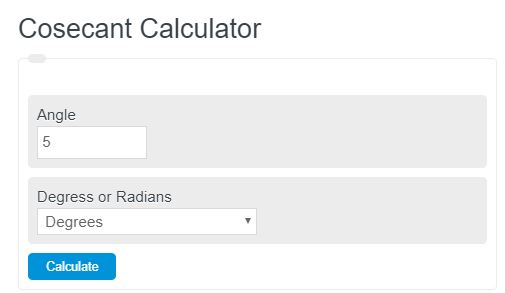Enter any angle into the Cosecant calculator. The calculator will display the result of that cosecant, also known as 1/sine(x).
Cosecant Formula
The following formula is used to calculate the value of a cosecant of an angle.
CSC(x) = 1/sin(x)
- Where CSC is the cosecant
- x is the angle in degrees or radians
As you can see from the equation above, the cosecant is equal to 1 divided by the sin of the same angle.
Cosecant Definition
Cosecant, commonly written as csc, is a trigonometric function that relates to the ratios of the sides of a right triangle. Specifically, it is the reciprocal of the sine function.
In mathematical terms, cosecant is defined as the ratio of the hypotenuse length divided by the length of the side opposite to a given angle in a right triangle.
How to calculate cosecant?
How to calculate cosecant
- Determine the angle you wish to evaluate
Calculate or measure the angle to take the cosecant.
- Take the sin of the angle
Take the sine value of that angle.
- Calculate the cosecant
Divide 1 by the sine value calculated in step 2 to determine the cosecant.
FAQ
What is the relationship between cosecant and sine?
Cosecant is the reciprocal of the sine function. This means that the cosecant of an angle is equal to 1 divided by the sine of that same angle.
Can cosecant be calculated for any angle?
Yes, cosecant can be calculated for any angle, except for those where the sine of the angle is zero, as dividing by zero is undefined. These are typically at 0°, 180°, and multiples thereof in the context of degrees.
Why is the cosecant function important in trigonometry?
The cosecant function is important in trigonometry because it helps in solving equations and problems related to right triangles. It provides a way to understand and calculate the relationships between the angles and sides of triangles, which is essential in many fields of science and engineering.
How do radians and degrees affect the calculation of cosecant?
The calculation of cosecant can be performed with angles measured either in radians or degrees. The choice of units does not change the fundamental relationship that the cosecant of an angle is the reciprocal of its sine; however, the numerical value of the sine—and consequently the cosecant—will depend on whether the angle is expressed in radians or degrees.

